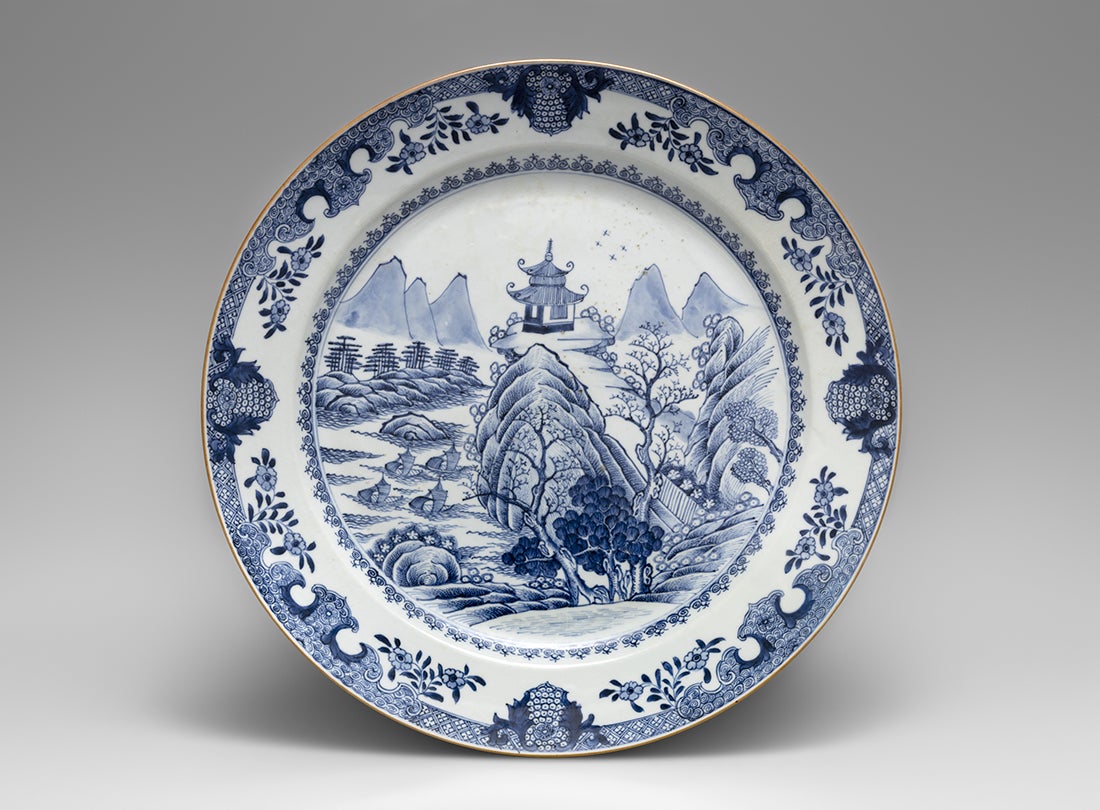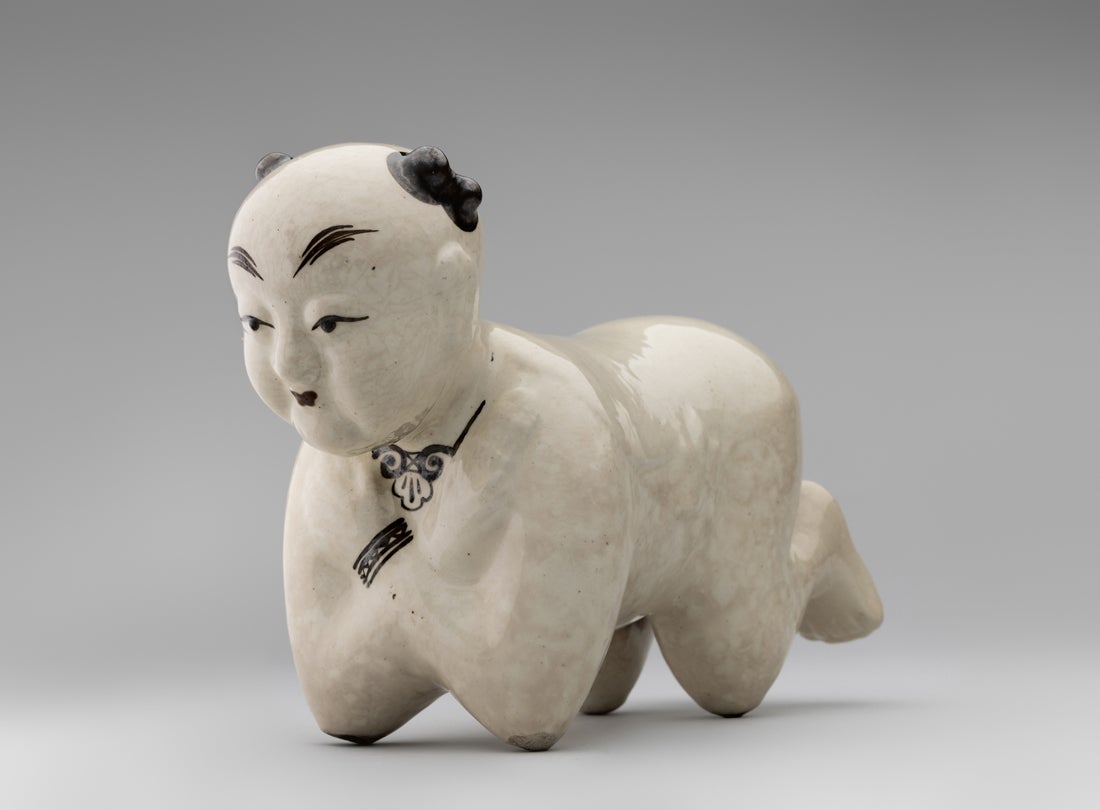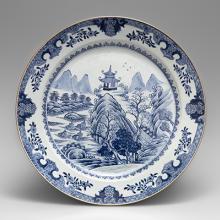International Terminal






人物黃酒陶甕
Rice wine or millet wine jar with unidentified figures early 20th century
Hubei province, China
stoneware, glaze
Collection of Sally Yu Leung
L2024.0301.029
西遊記人物酒甕
Jar with Journey to the West characters early 20th century
Hubei province, China
stoneware, glaze
Collection of Sally Yu Leung
L2024.0301.028
西遊記
Journey to the West
These stoneware pots have figural motifs. The pot on the right depicts the central characters in Journey to the West, an epic, late sixteenth-century folk novel, attributed to Wu Cheng’en (possibly 1500–80). It tells the journey of the Chinese Buddhist monk, Tripitaka, who is based on the real-life Buddhist monk Xuanzang. He traveled to India from China on foot to obtain Buddhist scriptures to bring back to China, a journey that took him ten years. In the fantastical tale, three companions—the mischievous Monkey King, Pigsy, the licentious half-human, half-pig being, and Sandy, a former water demon—accompany Tripitaka. The most notable character, Monkey King, possesses supernatural powers that allow him to shapeshift. As punishment for his shenanigans, the Monkey King was pinned beneath a mountain for five hundred years by the Buddha before being freed to protect the pious monk on his fourteen-year journey. Together the group faces numerous challenges and obstacles before completing their quest—from battling demons to confronting treacherous creatures. Journey to the West is one of the most quintessential stories in Chinese literature and remains incredibly popular in and outside of China.
外銷瓷
Charger made for export c. 1780
Qing dynasty (1644–1911)
Jiangxi province, China
porcelain, underglaze-blue decoration
Collection of Sally Yu Leung
L2024.0301.006
青花瓷
Blue-and-White Ware
Porcelain developed in China during the Tang dynasty (618–907) and continued to be refined in proceeding centuries. Made with kaolin clay and other additives and fired at extremely high temperatures (above 1260 degrees Celsius or 2300 degrees Fahrenheit), porcelain results in a translucent, milky, white glass-like surface. Though porcelain was made throughout China, the kilns at Jingdezhen, located in the southeastern province of Jiangxi, perfected the art of porcelain painted with cobalt-blue decoration during the fourteenth century. The blue color came from cobalt oxide, which was initially imported from the Middle East. Exceptional artisans carefully hand painted designs onto porcelain using a brush. Long admired throughout Asia, the Middle East, and Europe, Chinese blue-and-white porcelain was highly sought after for its beauty, durability, and pure-white color and widely exported beginning in the Ming dynasty (1368–1644). The Chinese designed a variety of different pictorial patterns to suit various markets. Blue-and-white porcelain remains one of the most imitated and influential advancements in the history of ceramics. China and the kilns at Jingdezhen continue to produce porcelain today—no other kiln complex can claim such a long and continuous history.
陶獅
Guardian lion
Qing dynasty (1644–1911)
Shiwan, Guangdong province
China
earthenware, glaze
Courtesy of Guangzhen Zhou
L2024.0302.007.02
陶獅
Guardian Lions
The fearless lion motif was introduced to China alongside Buddhism where it symbolizes strength and protection. Lions also signify harmony, blessings, and high military rank. The lion appears frequently in Chinese decorative arts; highly stylized, it bears only a faint resemblance to the real animal. The Chinese word for “lion” can be a pun for “generations” (shi), “master” (shi), and “thoughts” (si), all pronounced the same way. Because they are powerful creatures, guardian lions (“foo dogs”) guard the entrances to temples and public buildings. Today, they can even be found outside of restaurants and hotels in both China and other places around the world where Chinese have emigrated. Created in pairs from stone, bronze, or ceramic, the male plays with a brocaded ball and the female tames a cub under her left paw. The male is usually placed to the left of the doorway and the female to the right. Singular or pairs of lions may also appear nearby the entrances to homes where they provide protection to their owners.
帽筒
Hat stand late 19th century
Signed: Zhan Yishun
Produced by the Lisheng Shop of Jiangxi
Qing Dynasty (1644–1911)
porcelain, glaze
Jiangxi province, China
Collection of Sally Yu Leung
L2024.0301.016
太獅少獅帽筒
Hat stand with lions 1922
Signed: Rong Shunxiang
Jingdezhen, Jiangxi province, China
porcelain, glaze
Collection of Sally Yu Leung
L2024.0301.012
三星人物帽筒
Hat stand with Three Star Gods 19th century
Qing dynasty (1644–1911)
Jingdezhen, Jiangxi province, China
porcelain, glaze
Collection of Sally Yu Leung
L2024.0301.014
帽筒
Hat Stands
Once ubiquitous in Chinese dress, hats were worn on most public occasions. Historically, one’s rank, the occasion, and time of year dictated the type of hat worn. Hats, often displayed on decorative stands, were scented with fragrant materials that diffused through hollows to impart the owner’s hat with a pleasant scent. Crafted from materials including lacquered wood, bronze, and clay, hat stands were decorated with a variety of motifs. The motif of a large lion with several small lions on the hat stand at center does not necessarily suggest maternal bliss. Rather, as the accompanying text on the back of the hat stand explicitly states, it plays on the Chinese pronunciation for “big lion and small lions” (dashi xiaoshi 大獅小獅), which closely resembles the phrase “taishi shaoshi 太師少師,” or “may you and your descendant achieve high rank.” Many hat stands and other ceramic objects display auspicious figures, such as the Three Star Gods seen on the hat stand at right. Even today, these figures and other folk deities are regarded as powerful agents of good fortune.
陶獅燭台一對
Pair of lion candleholders c. 1850–1900
Qing dynasty (1644–1911)
Shanxi, China
glazed pottery
Collection of Sally Yu Leung
L2024.0301.021.01-.02
油燈與燭台
Candleholders and Oil Lamps
Before the invention of matches, oil lamps allowed people to maintain a source of fire and provided light in the evenings. Many lamps and candleholders take the shape of animals, such as elephants, lions, and cats, all of which evoke auspicious attributes. In Chinese art, a pair of animals or birds of approximately the same size generally represent a male and female or couple in a state of conjugal fidelity. A larger and smaller pairing of animals, usually elephants or lions, typically depict a senior-junior relationship.
童子枕
Toddler headrest early 20th century
northern China
Cizhou ware
white-glazed stoneware
Collection of Sally Yu Leung
L2024.0301.008
瓷枕
Headrests
From ancient periods to modern times, humans have made rigid pillows. Headrests were once a staple of domestic furniture in China used by both the living and in burials. In fact, so many headrests were discovered in Chinese burial grounds that scholars once believed they were used solely for this purpose. The Chinese ceramic pillow tradition reached its peak from 900 to 1350. During these eras, pillow production greatly increased, and in many areas, the custom of using ceramic pillows appears to have spread among various segments of the population. In the 9th century, zoomorphic forms gained in popularity, particularly guardian images of lions and tigers. Such imagery was believed to ward off dangerous spirits that threatened the living and the dead. Animal motifs continued to appear on headrests over the centuries to provide protection during sleep. During the Song dynasty (960–1279) many ceramic pillows began to depict plump baby boys. These headrests served several purposes: to aid in pregnancy and to encourage the birth of sons to ensure the continuation of the family line. This headrest most likely served as a decorative object.





